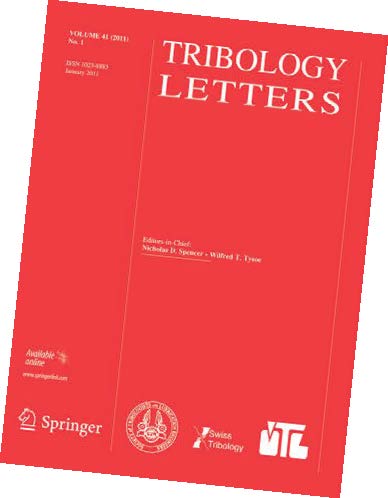Experiment and Theory: Rubbing along together
Drs. Wilfred T. Tysoe & Nicholas D. Spencer | TLT Cutting Edge June 2013
A special issue of Tribology Letters highlights collaborations between experimentalists and theorists.

IN THE FIRST OF THESE COLUMNS, we pointed out that Newton’s laws of motion and Amontons’ laws of friction were published at almost the same time (at the end of the 17th Century) and that, while Newton’s initial laws have evolved into other theories such as relativity and quantum mechanics, the understanding of Amontons’ laws, by contrast, has been much slower. This is, in part, because of the difficulties in interrogating a sliding, solid-solid interface and because of the complexity of the processes occurring at that interface. However, the intervening decade since the publication of that first article has seen remarkable advances in both experimental and theoretical capabilities.
Tribological experiments are now routinely carried out with exquisite delicacy by means of atomic force or friction-force microscopes and also in well-controlled, ultrahigh vacuum environments to obtain well-characterized surfaces that are free of contaminants. Tribometers have been designed not only to measure friction forces but also to monitor the nature of the interface either
in situ or just after rubbing.
At the same time, theoretical methods such as molecular dynamics simulations and first-principles quantum calculations now allow the complexities of the processes occurring at the sliding interface to be modeled with unprecedented precision. This growth has, in part, been due to the ready availability of vast computing power and the development of parallel codes that allow calculations to be carried out simultaneously on a large number of processors.
We have arguably now reached the point at which theorists and modelers can analyze the systems for which detailed experimental data can be obtained. Combined with these advances has been a growth in the range of analytical tools that can explore the nature of the surface after sliding. These range from focused-ion-beam techniques that can be used to obtain information on how the subsurface region has evolved, to surface-analytical methods such as X-ray photoelectron spectroscopy that can provide detailed information on the surface composition.
With increased experimental and theoretical sophistication inevitably comes increased specialization. However, scientific advances arise from a close interplay between experiment and theory. In the spirit of encouraging closer collaborations between practitioners of these two vital aspects of tribology research,
Tribology Letters has published a special issue titled “Combining Experiment and Theory in Tribology,” which is guest co-edited by STLE-member Dr. Ashlie Martini of the School of Engineering at the University of California-Merced.
The issue includes papers on a wide array of topics, ranging from contact mechanics of skin and textured surfaces to friction of elastomers and step-edges on graphite. It addresses a number of theoretical approaches, from quantum theory of tribochemistry and sliding friction, to molecular dynamics simulations of third-body formation. Other topics include surface roughness, the properties of films formed from zinc dialkyldithiophosphate and elastohydrodynamic properties of fluid interfaces.
We hope that this special issue will spur further collaborative efforts between experimentalists and theorists. All papers published in
Tribology Letters, including this special issue, are available free online to STLE members and can be accessed in the Members’ Only area of
www.stle.org.
FOR FURTHER READING
1.
Special Issue: Combining Experiment and Theory in Tribology,
Tribology Letters, (2013),
50(1).
 Eddy Tysoe is a Distinguished Professor of Physical Chemistry at the University of Wisconsin-Milwaukee. You can reach him at wtt@uwm.edu
Eddy Tysoe is a Distinguished Professor of Physical Chemistry at the University of Wisconsin-Milwaukee. You can reach him at wtt@uwm.edu.
 Nic Spencer is professor of surface science and technology at the ETH Zurich, Switzerland. Both serve as editors-in-chief of STLE-affiliated Tribology Letters journal. You can reach him at nspencer@ethz.ch
Nic Spencer is professor of surface science and technology at the ETH Zurich, Switzerland. Both serve as editors-in-chief of STLE-affiliated Tribology Letters journal. You can reach him at nspencer@ethz.ch.